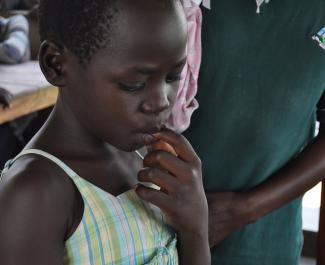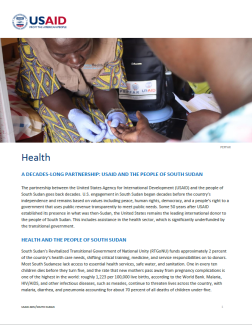HEALTH AND THE PEOPLE OF SOUTH SUDAN
South Sudan’s Revitalized Transitional Government of National Unity (RTGoNU) funds approximately 2 percent of the country’s health care needs, shifting critical training, medicine, and service responsibilities on to donors. Most South Sudanese lack access to essential health services, safe water, and sanitation. One in every ten children dies before they turn five, and the rate that new mothers pass away from pregnancy complications is one of the highest in the world: roughly 1,223 per 100,000 live births, according to the World Bank. Malaria, HIV/AIDS, and other infectious diseases, such as measles, continue to threaten lives across the country, with malaria, diarrhea, and pneumonia accounting for about 70 percent of all deaths of children under-five. USAID’s health projects prevent child and maternal deaths, help control the HIV/AIDS epidemic, and increase access to clean water.
IMPROVING COMMUNITY BASED DISEASE SURVEILLANCE
USAID continues to control new and existing infectious diseases in South Sudan through disease surveillance; outbreak response support; and education. Since 2005, USAID has supported community based disease surveillance through the Global Polio Eradication Initiative through partners like the Core Group Partner’s Project which operates in the three Equatoria states and will expand to 16 additional counties in Fiscal Year 2024. The project works through Home Health Promoters to conduct house-to-house visits to provide health education, screen children for paralysis, screen family members for outbreak prone diseases, and trace and refer children who have missed their immunizations. Thanks to numerous polio campaigns—funded by USAID and other donors and conducted by UNICEF and WHO—South Sudan has not reported cases of wild polio virus since July 2009. South Sudan remains prone to disease outbreaks, however, due to the country’s weak health and immunization systems. Porous borders and repeated polio outbreaks in the horn of Africa compound the risk of new outbreaks.
PREVENTING CHILD AND MATERNAL DEATHS
New mothers and their babies face extraordinary obstacles accessing quality health care. With limited access to health facilities and poor access to family planning services, mothers often struggle to provide adequate health care for their children and take care of their own health. On average, South Sudanese women give birth to seven children and only 11 percent of mothers give birth in a healthcare facility. Through USAID’s contribution to the multi-donor Health Pooled Fund—the largest maternal and child health care program in South Sudan—more than 1.9 million children under-five gained access to basic health services between April 2022 and March 2023. The program keeps more than 500 health facilities operational and supports nearly 4,000 health workers in seven of ten states through a blend of community primary health care outreach, health center service delivery, training, provision of supplies and medicines, and technical assistance in quality improvement and monitoring. Since 2016, USAID has contributed more than $100 million to the fund to improve the availability and quality of health services for South Sudanese families. To ensure families have the resources and knowledge they need to lead healthy lives, USAID also promotes voluntary family planning and ensures regular distribution of family planning commodities to health facilities across the country. This has led to more than 220,000 women adopting a modern family planning method since 2020.
CONTROLLING THE HIV/AIDS EPIDEMIC
South Sudan has an estimated HIV prevalence rate of 1.9 percent. Only about 200 health facilities across the country have the staff and resources needed to provide comprehensive care for the estimated 160,000 people living with HIV. Of those living with HIV, only 34 percent are on life-saving antiretroviral treatment (ART). Low ART coverage is primarily due to poor infrastructure, lack of awareness of HIV— just 39 percent of people living with HIV know their status—stigma, and discrimination. USAID’s $39.6 million Advancing HIV/AIDS Epidemic Control project provides comprehensive HIV services at 14 health facilities that reach nearly 12,000 people living with HIV. Our assistance helps improve access to quality and comprehensive HIV testing and counseling, prevents mother-to-child transmission, and provides antiretroviral therapy services.
Complementing USAID’s work, the U.S. Centers for Disease Control strengthens disease surveillance capabilities, laboratory systems, data and health information management systems, and the public health workforce in areas where USAID is not present. Through the U.S. President’s Emergency Plan for AIDS Relief (PEPFAR), USAID’s work at 14 health facilities ensures that people living with HIV—particularly those who are often marginalized such as women, girls, and those with disabilities—stay on their treatment plan and are virally suppressed. In Juba, USAID has reached more than 3,900 orphans and vulnerable children and more than 4,000 at-risk adolescent girls and young women with social protection services, ensuring those who are living with HIV adhere to their treatment plan and helping others minimize their risk of contracting HIV.
IMPROVING ACCESS TO BASIC DRINKING WATER AND SANITATION
Nearly 60 percent of South Sudanese do not have access to basic safe drinking water, putting nearly two-thirds of the population at risk of water-related diseases. About one in ten people has access to basic sanitation and nearly three in four people living in rural areas practice open defecation. USAID works from the national level to the payam and boma levels to increase access to basic water and sanitation services. We do this by sharing technical knowledge with leaders to inform national water strategies, working with local communities to construct and refurbish water points and systems—such as bore holes or solar-powered water distribution systems—building latrines, and working with communities to end open defecation.

Sarah Armstrong/USAID

